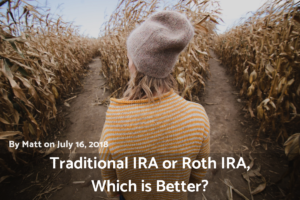Listen on iTunes.
Listen on Google.
Listen on Stitcher.
If you’re self employed you have a huge advantage when saving for retirement. You’re the employer and employee. You ultimately decide what type of retirement plan your company will have. So as the business owner and employee of the business you can save a lot for the future while getting some benefits in the present.
When it comes down to it the three retirement buckets we’re going to discuss are generally what most of us who are self-employed would use when integrating a retirement plan with the business.
SEP IRA (Simplified Employee Pension)
Let’s get started with the SEP IRA. SEP stands for Simplified Employee Pension. This is a retirement plan available to any business of any size. Whether you have 1 or 1,000 employees you can establish a SEP IRA by adopting Form 5305-SEP, a SEP prototype or an individually designed plan document. If Form 5305-SEP is used, you cannot have any other retirement plan (except another SEP). There are no filing requirements for the employer.
For SEP IRAs, only the employer contributes to traditional IRAs (SEP-IRAs) set up for each eligible employee. The employee is always 100% vested in (or, has ownership of) all SEP-IRA money. Remember, only the employer can contribute to the SEP-IRA. The employee cannot contribute.
Contributions an employer can make to an employee’s SEP-IRA can’t be more than either:
- 25% of the employee’s compensation, or
- $55,000 for 2018 ($54,000 for 2017)
When it comes to taxes, you can take deductions on your yearly tax per IRS publication 560 which talks about retirement plans for small businesses. Taxes for each individual retirement plan can be it’s own individual episode. Just know that you are getting some kind of tax benefit for this SEP IRA and the other self-employed retirement plans that we’ll discuss. You will want to check up on the IRS website for more details or speak to a tax professional who can guide you further.
Who would want a SEP IRA? Those who are self-employed, have freelance income or are the owner of a small business.
You can open up a SEP IRA at Vanguard, Charles Schwab, Fidelity, TD Ameritrade just to name a few. If I were interested in a SEP IRA I’d want to be sure that I had access to low cost index funds where fees are low.
SIMPLE IRA (Savings Incentive Match PLan for Employees)
A SIMPLE IRA plan (Savings Incentive Match PLan for Employees) allows employees and employers to contribute to traditional IRAs set up for employees. It is ideally suited as a start-up retirement savings plan for small employers not currently sponsoring a retirement plan.
SIMPLE IRAs are available to any small business, usually with 100 or fewer employees. You can establish this plan by adopting Form 5304-SIMPLE, 5305-SIMPLE, a SIMPLE IRA prototype or an individually designed plan document.
You will want to note that the employer cannot have any other retirement plan. There are no filing requirement for the employer just like a SEP IRA.
When it comes to contributions the employer is required to contribute each year either a matching contribution up to 3% of compensation (not limited by the annual compensation limit), or 2% nonelective contribution for each eligible employee.
Employees may elect to contribute and they are always 100% vested in (or, has ownership of) all SIMPLE IRA money.
Solo 401(k)
Actually called a one-participant 401(k) plan, a solo 401k is a traditional 401(k) plan covering a business owner with no employees, or that person and his or her spouse. These plans have the same rules and requirements as any other 401(k) plan.
The business owner is the employee and employer. Contributions can be made to the plan in both roles. The owner can contribute both elective deferrals up to 100% of compensation and nonelective contributions up to 25% of compensation.
Total contributions to a participant’s account, not counting catch-up contributions for those age 50 and over, cannot be more than $55,000.
A business owner who is also employed by a second company and participating in its 401(k) plan should bear in mind that his limits on elective deferrals are by person, not by plan. He or she must consider the limit for all elective deferrals he makes during a year.



